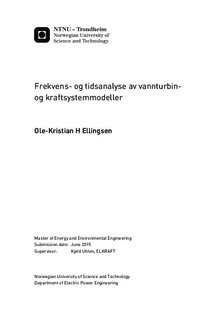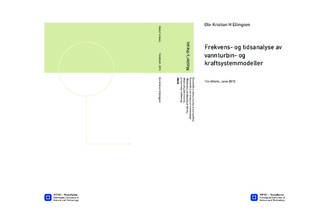| dc.description.abstract | In this report a hydro turbine model and a power system model have been developed. The goal is to develop models capable of preforming in a frequency analysis of the Nordic synchronous area and that these models can help to investigate floating frequencies in the Nordic power system.
The hydro model has non-linear penstock and turbine dynamics and it is governed by PID-governor. The power system is modelled as a one-bus system, based on the mechanical swing equations. Both the turbine model and the power system model have been tested with a time series analysis and a frequency analysis. Particularly the effect of load damping and inertia has been tested.
The time series analysis shows that the hydro model can work as a substitute for existing models, both in a standalone comparison to other hydro models, and in a larger power system model. The time series does find that the hydro turbine is less predictable in behaviour. As the model is non-linear, instabilities were found in some cases, when trying to find the critical stable operating point.
The power system model was also tested to discover how it behaved in a time series analysis. It was scaled to an equivalent of the Nordic system and analysed to find the response to disturbances in the system. The system has been analysed to show the differences in response to a fully loaded system and a sparsely loaded system. The test show a significant deterioration in the system stability when less inertia was available in the system.
A frequency analysis was conducted on both the turbine model and the power system model to test the effect of inertia and load damping. The test on the hydro turbine model confirmed that it was unstable for a selection of system parameters. Stable simulations show that the models tend to resonate at frequencies between 0.004 Hz and 0.022 Hz. The resonance frequency, as well as amplitude, drops as the system inertia increases.
Frequency analysis of the Nordic system equivalent support this data. This test found resonance for frequencies in the between 0.014 Hz and 0.022 Hz. This corresponds to a time period of oscillation between 45 and 70 seconds. This is similar to the frequency oscillation found in the system today. Test show that the effect of the load damping decreases as the system grows in size. | |

